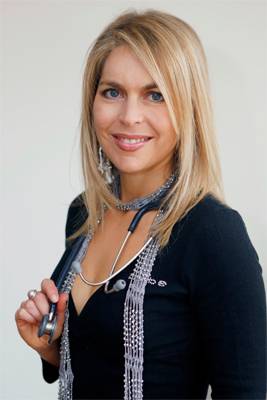Valentine's Day and Pap Tests: What do they have in common?

Valentine's Day and Pap Tests: What do they have in common?
Valentine's Day. It's a celebration of love; traditionally, romantic love... This year on the tail of a recent Newspoll survey, the Australian Cervical Cancer Foundation (ACCF) is urging Australian women to remember themselves with a caring gesture to their most feminine parts on Valentine's Day, by committing to make a date with their doctor for a Pap test.
Conducted in January 2012, the Newspoll survey* reveals over 920,000 Australian women (13%) have never had a Pap test, despite the introduction of widespread Pap testing more than 20 years ago. It also shows 40% are not having regular Pap tests every two years as recommended.
In support of this Valentine's Day message of encouragement from the Australian Cervical Cancer Foundation, Dr Ginni Mansberg, resident doctor on Seven Network's Sunrise and Morning Show, says it's time for Australian women to treat this precious part of their body with the same level of TLC they lavish on the rest of their body parts; face, skin, hair, fingers and toes!
'Admittedly not as pleasant as a pedicure, a facial, or a body wrap, but a Pap test is as much about looking after yourself as a visit to your beauty therapist or local spa! But most importantly, Pap tests can be life-saving. They are the best way to find the early stages of cervical disease which could one day turn into cancer if left undetected or untreated," she says.
The survey found that two popular occasions for -personal and intimate grooming' are Valentine's Day and Pap test appointments.
Results reveal two-in-five Australian women (42%) have some form of personal grooming lined up in preparation for Valentine's Day this year with the majority of these reaching for the wax or shaver:
21% will -tidy up' their bikini line area or have a -Brazilian'
37% will wax, shave or have laser hair removal treatment on their legs
25% will style their hair by visiting a hairdresser or with a -DIY hairdo'
11% will have a manicure or pedicure
The survey also showed that of the Australian women who have Pap tests, nearly all (97%) plan some type of -personal grooming' in preparation for their Pap test:
28% organise some form of -downstairs grooming' – from a trim or bikini line -tidy up' to even a -Brazilian'
47% will wax, shave or laser their legs
29% make sure they have a morning appointment with their doctor
37% select certain underwear for the occasion
32% plan their wardrobe for the day by wearing certain clothing
'These findings don't surprise me at all. As a GP, and as a woman, I know how women of all ages can be conscious of how they look – particularly when we're in a vulnerable position, like having a Pap test.
'By setting a Pap test date around Valentine's Day, it's is an easy reminder and a great personal commitment to yourself. Personal grooming is a special priority for many women on both occasions, so it means they'll already be feeling and looking great, and the experience will be done and dusted for another two years!
'I've had so many patients who have postponed having a Pap test, usually out of embarrassment, only to return an abnormal result when they eventually get around to it. Then of course they kick themselves because the earlier you detect an abnormality, the better the outlook," said Dr Mansberg.
The most recent Australian Institute of Health & Welfare (AIHW) figures show 2.6 million Australian women are putting off this crucial test. As a consequence, over 700 women are diagnosed with cervical cancer each year and four women lose their lives to the disease every week in Australia.
'These figures are very concerning. The fact is the majority of women diagnosed with invasive cervical cancer have not had Pap tests. This is frightening and is a reason why education on the devastating effects of missing Pap tests is critical to help reduce the number of cancer cases each year," said Joe Tooma, Chief Executive Officer of the Australian Cervical Cancer Foundation (ACCF).
'The ACCF ultimately wants to see the end of cervical cancer altogether. With preventative measures like Pap tests and the HPV vaccine, Australian women have the best chance to protect themselves from cervical disease.
'As the ACCF's scientific advisor and inventor of the HPV vaccine, Professor Ian Frazer says, cervical cancer is now a largely preventable disease," added Mr Tooma.
Cervical Screening in Australia Fact Sheet
Cervical cancer is the second most common cancer worldwide in women over 15 years of age1, although it is not as common in Australia, due in large part to routine Pap testing.
Pap tests:
As there are usually no symptoms related to the early stages of cervical cancer, regular Pap tests are the best way to detect the early stages of cervical disease.
A Pap test is usually performed by a doctor or nurse to check for abnormal changes to the cells of the cervix. These changes act as an early warning sign that cervical disease or cancer may develop in the future.
The Australian National Cervical Screening Program recommends all women who have ever been sexually active have a Pap test every two years from the age of 18 until the age of 70, even if they have had the HPV vaccine.
There are two types of Pap tests available to Australian women – the conventional Pap test (Pap smear) and another test known as liquid-based cytology (LBC). A woman's cervical cells are collected in the same way by the doctor or nurse; however they are processed differently and have different effectiveness rates.
Cervical disease:
Cervical disease or cancer usually takes years to develop.
When detected early, cervical abnormalities are highly treatable.
Close to 75,000 Pap tests in Australia are diagnosed as -abnormal' over a two-year screening period. More than half of these (44,000) are diagnosed as high-grade where further investigation, surgery or treatment is usually required.
In Australia, cervical abnormalities are typically classed as:
Low grade: signifies minor changes to the cells of the cervix and they usually disappear on their own. Treatment is not normally required as the body will naturally clear the virus in about 8-14 months. Most women are advised to return in a year for a follow-up Pap test.
High grade: indicates more serious cell changes. They have a greater probability of progressing to cancer. Australian women with high grade abnormalities are normally referred to a gynaecologist for further investigation and treatment.
Cervical cancer:
Despite the success of Australia's cervical screening program, over 700 Australian women are diagnosed with cervical cancer each year.
Sadly each week about four Australian women lose their lives to this disease.
Most women who develop cervical cancer have not had regular Pap tests.
Even though the National Cervical Screening Program was introduced 20 years ago, there are still 2.6 million Australian women who do not have Pap tests every two years (that's 40% of women eligible for the program).
The human Papillomavirus (HPV) :
HPV is a very common virus and it is almost always the cause of cervical cancer. It is often called the 'common cold" of sexual activity.
As many as four-in-five women who have ever been sexually active will be infected with the virus at some point, although most do not develop cervical cancer.
There are over 100 different types of HPV, most of which are harmless. Around 14 types have been linked to cervical cancer.
The two most dangerous HPV types are the cancer-causing HPV 16 and 18 – together they account for more than 70% of all cervical cancer cases.
HPV vaccine:
HPV vaccination is an important development in helping protect women from acquiring cervical disease, however it only provides partial protection, therefore it is crucial women continue to have routine Pap tests every two years.
The HPV vaccine protects women against the two main cancer-causing types of HPV (16 and 18) responsible for 70% of cervical cancer, however it may not protect women against the 12 other HPV types that cause the remaining 30% of cervical cancer cases.
ï€In Australia, the HPV vaccine is approved for females between the ages of 9 and 26 years. Free HPV vaccine is available under the National Immunisation Program. There is currently an ongoing school-based program routinely delivered to girls in the first year of secondary school (12-13 years of age).
Risk factors:
All sexually-active women are at risk of being affected by cervical disease. However, the risk of developing cervical disease or cancer increases with age.
Most cervical cancer cases are diagnosed between the ages of 35 and 55 years.
The women most at risk of cervical disease and cancer include those who have had more than one sexual partner and those who became sexually active at a young age.
Rates of cervical cancer amongst indigenous women is more than twice that of nonindigenous women and indigenous women are five times more likely to die from cervical cancer than non-indigenous women.
About the Australian Cervical Cancer Foundation (ACCF) is the brainchild of Professor Ian Frazer and several of his close colleagues. It is a young charity with a big vision. The ACCF is dedicated to eliminating cervical cancer in Australia and in the developing world where, in many countries, cervical cancer is the main cancer killer of women. Worldwide over 250,000 women a year die from cervical cancer – that is one woman every two minutes. The ACCF aims to: promote awareness and prevention of cervical cancer in all communities including indigenous; support women living with cervical cancer and their families; facilitate education for healthcare professionals on cervical cancer; provide free HPV vaccine to girls in developing countries; promote screening for cervical cancer; and facilitate the treatment of the disease in Australia and the developing world.
MORE





